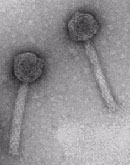
Research / P2 / Mechanism of Transcription Activation by a ... Zinc-Binding Transcription Factor

|
Mechanism of Transcription Activation by a Phage-Encoded, Zinc-Binding Transcription Factor Late gene expression in the P2- related temperate phages is under the positive control of a family of small, phage-encoded transcription factors exemplified by P2 Ogr. These proteins constitute a novel class of zinc-binding proteins which bear little sequence or structural similarity to other known prokaryotic transcription factors. Genetic analysis and in vitro binding studies have identified an unusual activator binding site upstream of late promoters which includes an interrupted element of dyad symmetry. Recognition of DNA by these phage-encoded transcription factors is predicted to involve contacts in three adjacent major grooves. We are investigating the binding of activator to DNA using NucC, a member of the P2 Ogr family encoded by a cryptic prophage in Serratia marcescens. In recent studies, DNA bending by NucC was measured by a gel mobility shift assay, using fragments derived from a circular permutation vector carrying a NucC binding site. Specific DNA determinants important in binding site recognition by NucC have been identified using a variety of chemical protection and interference studies. Current studies are directed towards elucidating the stoichiometry of activator binding and identifying, via genetic and crosslinking experiments, specific residues in NucC that play a role in DNA recognition. |





